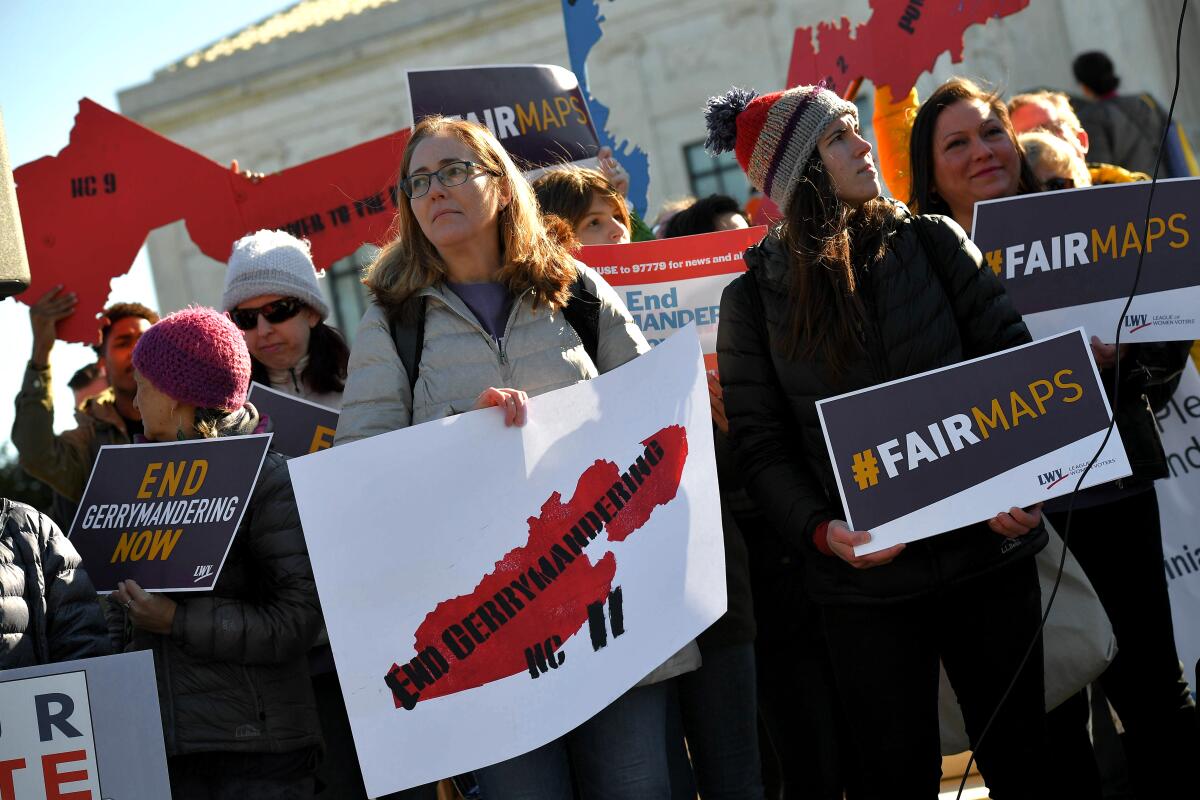Editorial: California got rid of gerrymandering — don’t cave now

- Share via
California’s independent commission tasked with drawing political boundaries is in the homestretch of crafting maps that will determine legislative and congressional districts for the next decade. And not everyone is happy about what the commission has proposed so far.
Both Democratic and Republican operatives are grumbling about the current drafts. They create more competitive districts than California has now and put dozens of state lawmakers and members of Congress in the same district as other incumbents.
That’s messy for politicians — but fine for voters and good for a healthy democracy.
We want politicians to compete for our votes. That’s why voters in 2008 and 2010 approved the nonpartisan redistricting system California has now, a reform The Times also supported. Now, instead of having lines drawn by politicians looking out for their own interests, we have a commission of ordinary citizens — including five Democrats, five Republicans and four independents — who draw new districts every 10 years based on updated census data and community interests.
But California is one of only eight states that have embraced this nonpartisan approach. In most states, politicians still control the process. That leads to gerrymandering, the drawing of political districts by the party in power for the purpose of maintaining control. They do it by carving up the map so that voters of the opposition party are packed into fewer districts, or split up into many districts to dilute their votes. Democrats in Oregon and Illinois, and Republicans in North Carolina, Texas and Ohio, have drawn such unfair congressional maps that analysts at the Princeton Gerrymandering Project scored them all an F.
All of this will play a role in determining who wins control of the U.S. House of Representatives next year. Democrats are already at a disadvantage because the party in power usually suffers losses in midterm elections. Republicans control redistricting in 20 states and are expected to gerrymander districts in ways that further bolster their advantage.
So some Democrats say California’s nonpartisan system forces them to fight with one arm tied behind their back. If politicians in this deep blue state controlled the line-drawing, there would be fewer swing districts and even more Democratic wins. That’s not about to happen because it would take another ballot measure to dissolve the independent commission. But some on the left have begun calling for California to return to gerrymandering out of a fear that across the country Democrats are “unilaterally disarming” in the race to control the House.
Democrats currently hold 42 of California’s 53 House seats. They would probably hold 40 seats if the current draft maps were in effect, according to analysis by the Public Policy Institute of California. (The state is losing one House seat because population growth was slower here than in other parts of the nation.)
The lines are sure to change before the commission finalizes maps by the end of December. For now, though, Reps. Katie Porter (D-Irvine), Josh Harder (D-Turlock), Mike Levin (D-San Juan Capistrano), Devin Nunes (R-Tulare), Mike Garcia (R-Santa Clarita) and Darrell Issa (R-Bonsall) appear vulnerable to being ousted because of the way their districts were redrawn. Issa asked his constituents in the GOP stronghold of Fallbrook to lobby the commission to keep the community in his district, but apparently thought better of it and deleted the tweet.
We believe the country is better served with Democrats in control, given the dismaying extent to which the Republicans have caved to the extremists and far-right voices in their party. Too many congressional Republicans disrespected American voters in their refusal to certify the results of the 2020 presidential election, and have shown an abhorrent disdain for the rule of law in their unwillingness to investigate the Jan. 6 insurrection.
Nevertheless, even in these perilous times, keeping Democrats in control of the House in 2022 is not as important as maintaining a fair electoral system. And California has achieved that.
The California redistricting commission has been doing its work on Zoom, holding lengthy livestreamed meetings that include live map-drawing and hours upon hours of public comment. They’ve heard from civil rights advocates pushing for district lines that could empower Latino, Asian American and LGBTQ voters, and from thinly veiled partisans trying to influence the final maps to their advantage.
It’s clunky. And messy. But it’s all out in the open, for the most part. Earlier this year, the commission stumbled in its mission to be completely transparent. Even so, there’s none of the backroom wheeling and dealing that characterizes the map-drawing process in other states, and in the city of Los Angeles.
“There’s significantly more public engagement than we are seeing in a lot of the rest of the country,” said Adam Podowitz-Thomas of the Princeton Gerrymandering Project.
That’s a lot better than the old way, which was cloaked in mystery and partisan power trips, resulting in such crazy district lines that former California congressman Phil Burton once called them his “contribution to modern art.”
Let’s not return to elections based on a partisan masterpiece.
More to Read
A cure for the common opinion
Get thought-provoking perspectives with our weekly newsletter.
You may occasionally receive promotional content from the Los Angeles Times.










